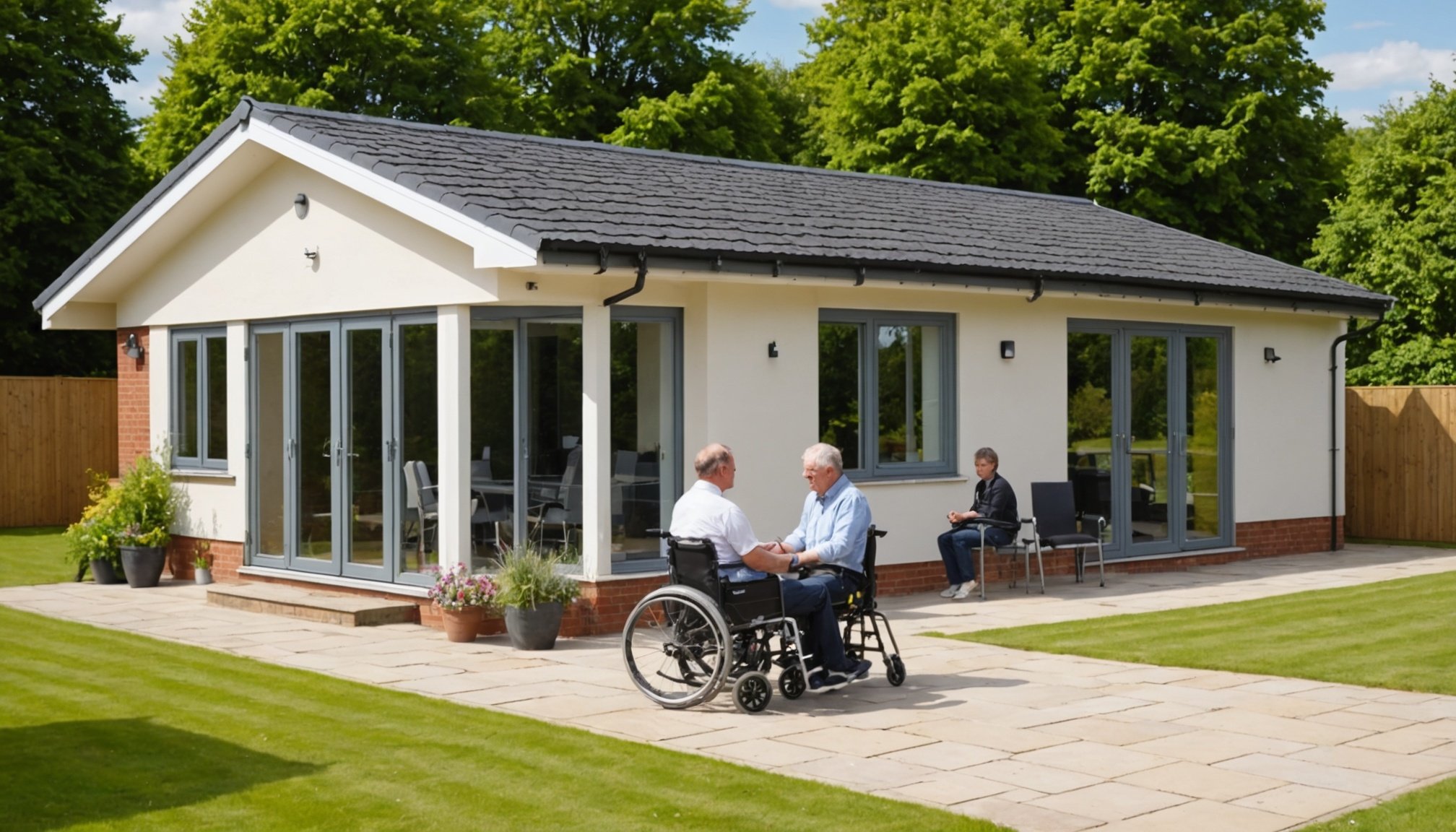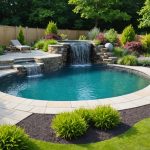Overview of Wheelchair Accessibility in UK Bungalows
Wheelchair accessibility is crucial for enhancing the quality of life for those with mobility constraints. In the UK, bungalows present unique challenges but also opportunities for creating accessible living spaces. Let’s explore these aspects in greater detail.
Accessibility Challenges in Bungalows
Bungalows, while typically single-story and seemingly ideal for wheelchair users, often require adjustments to meet accessibility standards. Common challenges include narrow doorways, uneven flooring, and inaccessible bathrooms. Retrofitting these homes often involves widening doorways, installing ramps, and ensuring that all essential features are reachable at wheelchair height.
Cela peut vous intéresser : Smart Water-Saving Tips for UK Homeowners: Efficient Ways to Maintain Your Backyard Pool
Benefits of Transforming Bungalows
Adapting bungalows into wheelchair-friendly homes brings significant advantages. For starters, it offers individuals with mobility issues increased independence and comfort. By incorporating essential features such as widened entryways and roll-in showers, these living spaces cater to the specific needs of wheelchair users. Moreover, accessible bungalows can enhance social connectivity by allowing easier home access for friends and family, thereby fostering a more inclusive and engaged community.
Improving wheelchair accessibility in UK bungalows isn’t just a matter of convenience—it’s an investment in the well-being and inclusivity of society as a whole. The right adaptations make a bungalow truly feel like a home for wheelchair users.
A lire en complément : Optimal Thread Count for Bedding in the UK”s Humid Climate: What You Need to Know
Planning Your Transformation
When embarking on a transformation, it is critical to start with a close evaluation of your individual needs and accessibility requirements. This involves understanding the specific features necessary to ensure the space is usable and comfortable for everyone. You should consider accessibility goals like accessible entrances, adequate lighting, and barrier-free design elements.
An effective planning process also involves establishing a clear budget for your transformation. Here, it’s imperative to assess how much you can afford and prioritize where to allocate your resources. This aids in preventing overspending and ensuring that all essential elements of accessibility are addressed within your financial constraints.
Working with professionals in design and layout is highly recommended to ensure your transformation is both functional and aesthetically pleasing. Professionals bring expertise to the table, helping you navigate potential design considerations while simultaneously helping fulfill your accessibility goals. They can provide insightful advice on material selection, spatial arrangement, and compliance with accessibility regulations.
Establishing a collaborative relationship with these experts is crucial. They mix technical know-how with your vision, accommodating your needs effectively while maintaining the elegance and functionality of the design. Such considerations help create a balanced, accessible environment that meets your aspirations.
Design Elements for Enhanced Accessibility
Catering to diverse needs, design elements facilitate greater inclusivity in physical spaces. By prioritising accessibility, we can ensure that everyone, from wheelchair users to those with mobility aids, finds buildings welcoming and navigable.
Creating Accessible Entrances
Setting a welcoming tone begins with the entrance. Ramps replace or complement stairs, granting easy access to all. When choosing materials, non-slip surfaces ensure safety, particularly in wet conditions. Gradual slopes prevent fatigue and assist in smoother navigation.
Modifying Doorways and Hallways
Crucial for movement, door widths and hallways must accommodate various needs. Expanding door widths, typically to at least 32 inches, allows wheelchairs and walkers to pass seamlessly. Consider pocket or sliding doors, which save space and ease access. Wider hallways, uncluttered, keep pathways open.
Designing Bathrooms for Accessibility
Bathrooms often need adjustments for optimal accessibility. Installing grab bars near toilets and in showers offer support and safety. Lowering fixtures like sinks and mirrors ensures usability for all individuals. Wider entry points enhance wheelchair accessibility, while roll-in showers replace traditional bathtubs, providing comfort and practicality. Prioritising accessibility in bathroom design transforms spaces into functional areas accommodating diverse requirements.
Regulatory Compliance and Building Regulations
Navigating the intricate landscape of UK building regulations requires a precise understanding, especially concerning accessibility. These regulations ensure that domestic properties accommodate all individuals, including those with mobility challenges. Compliance with these standards is not just advisable; it’s mandatory for developers and homeowners alike.
Key requirements for domestic properties involve ensuring access routes, such as ramps or lifts, are integrated into designs. For example, thresholds must be level for wheelchair users and doorways should have an adequate width for accessibility. Bathrooms and toilets often need adaptation to incorporate grab rails and meet size specifications to allow safe maneuvering.
Resources abound for those seeking guidance on these regulations. The UK Government’s planning portal offers comprehensive information and accessible documents aiding in understanding current legal requisites. Moreover, engaging with a certified regulatory advisor can streamline the process of achieving compliance. They offer insights that ensure building projects meet accessibility standards efficiently.
Understanding and adhering to these compliance requisites not only safeguard against legal repercussions but also promote inclusivity. Thus, familiarising oneself with the standards can facilitate the creation of environments that cater to everyone’s needs, reflecting a commitment to equitable living spaces.
Implementing Accessible Features
Integrating accessible features into a living space involves strategic installation and practical planning to ensure inclusivity. Practical solutions from real-life case studies point towards effective ways to enhance a home’s functionality.
Choosing Suitable Flooring
The selection of slip-resistant and durable flooring is paramount. Opting for materials like rubber or textured vinyl reduces the risk of slips, especially in areas prone to moisture, such as bathrooms and kitchens. Case studies highlight the effectiveness of non-slip surfaces in maintaining independence.
Selecting Furniture and Fittings
Proper arrangement of furniture is essential for maneuverability. This might involve open floor plans that provide clear paths and installing fittings—like lever-style handles—that are easily operated without a tight grip. These adjustments cater to varying needs and foster a more navigable environment.
Installing Technology for Accessibility
Incorporating smart home devices enhances autonomy. Devices such as voice-activated assistants and automated lighting allow for seamless interaction with the home environment, significantly improving everyday functioning. Practical solutions like these empower individuals, providing control over their surroundings.
Adopting these strategies ensures the home is equipped with accessible features that promote both safety and efficiency. Each choice, from flooring to technology, plays a crucial role in crafting a space that supports independence and accessibility.
Case Studies and Success Stories
Exploring real-life case studies offers valuable insights into successful bungalow transformations that have embraced best practices. One notable success story involves a small bungalow, which was completely revamped using innovative transformation examples. By including ramps and widened doorways, accessibility was vastly improved, transforming the living space into a haven for those with mobility challenges. The success of this project lies in its thoughtful design, incorporating both style and functionality, which serves as a guiding framework for similar renovations.
In another success story, a dilapidated bungalow was enhanced with energy-efficient solutions, including solar panels and LED lighting. This not only reduced energy bills but also increased the home’s market value. The architectural and engineering teams involved showcased their expertise by seamlessly blending sustainability with aesthetic appeal, setting a benchmark for future projects.
Lessons learned from these transformations highlight the importance of incorporating innovative solutions and designs from the outset. Whether it involves integrating smart home technology or utilising environmentally-friendly materials, these case studies demonstrate how a bungalow can be transformed into a modern, efficient dwelling. Such success stories inspire homeowners to reimagine their spaces, ensuring they are future-ready and aligned with current housing standards.
Finding Professionals and Resources
Navigating the world of accessibility can feel like an overwhelming task. Fortunately, there are numerous resources and specialist services available to aid in finding the right professionals.
For those looking to remodel or design accessible spaces, partnering with architects and contractors who have specific expertise in accessibility is crucial. These professionals can offer valuable insights and innovative solutions that adhere to accessibility standards.
Local and national support organizations are indispensable allies in this journey. Groups such as disability advocacy organizations often maintain directories or can recommend specialist services, guiding you to trusted professionals. They provide not just names, but also real-world insights into working with various experts.
In addition to these personal connections, the internet offers a wealth of information and guidance. Numerous websites host comprehensive resources and guides. These online resources can help in understanding the specific needs of accessibility projects, offering both general knowledge and specialized advice. Whether it’s finding professionals near you or accessing free toolkits, the digital realm is rich with potential support.
Seeking out, and utilizing, these resources ensures that your journey towards accessibility is both informed and supported.
Frequently Asked Questions about Accessibility Improvements
In this section, we will address some common questions related to accessibility improvements, offering practical advice to guide you through the process.
Understanding Financial Assistance Options
One frequent question is about financial assistance for accessibility improvements. Are there any grants available? Yes, various grants and funding options exist to support these upgrades. Organisations and government programs often offer financial assistance to help cover the costs associated with making your space more accessible.
Maintenance of Accessible Features
Another common inquiry is about maintaining accessibility features. Why is regular maintenance important? Ensuring the safety and effectiveness of accessible features necessitates regular upkeep. This is crucial for preventing accidents and ensuring the longevity of installations like ramps and elevators.
Preparing for Future Needs
How should one prepare for evolving accessibility requirements? It’s essential to consider future needs when planning accessibility improvements. Anticipating changes over time allows for smoother adaptations and reduces the need for abrupt, expensive modifications. By keeping informed about new technologies and standards, you can ensure that your space remains inclusive and welcoming.
By addressing these FAQs, you can make informed decisions and effectively plan for accessibility improvements in your environment.











